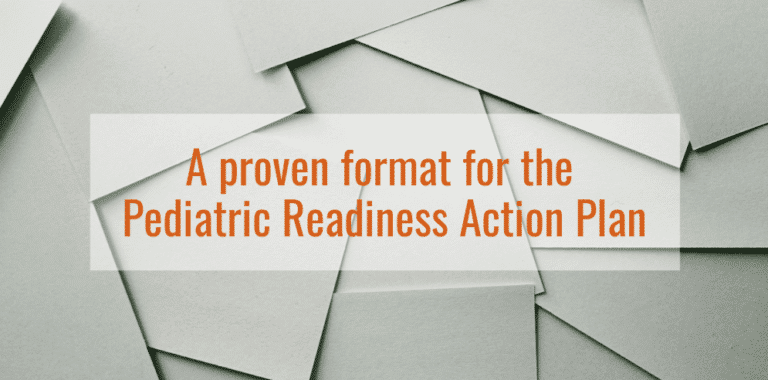Current standards from the American College of Surgeons (ACS) require all trauma centers to (1) perform a pediatric readiness assessment of the emergency department and (2) have a plan to address identified gaps.
The first part of this requirement is clear — Standard 5.10 of the Grey Book directs trauma center leaders to the assessment tool created by the National Pediatric Readiness Project (NPRP).
However, the second part of the requirement is not as narrowly defined. The related measure of compliance is simply, “Plan to address gaps identified through the pediatric readiness assessment”.
How detailed does this plan have to be? What formats are acceptable?
One option is to use the Pediatric Readiness Gap Analysis format developed by Eskenazi Health, a Level I trauma center in Indianapolis, for its recent ACS survey.
According to Sherri Marley, trauma program manager, ACS reviewers identified the Eskenazi Health gap analysis document as an exemplary action plan for improving pediatric readiness.
Simple presentation of gaps, targets and plans
The Pediatric Readiness Gap Analysis from Eskenazi Health is a simple chart that presents the ED’s current readiness to treat injured children, key opportunities for improvement, and summary action items for closing readiness gaps.
Pediatric Readiness Gap Analysis developed by trauma and ED leaders at the Smith Level I Shock Trauma Center at Eskenazi Health (click image to enlarge)
The focus is on conveying key details and high-level action points. For example, trauma and ED leaders identified pediatric-specific PI and quality assurance as a significant opportunity for improvement in pediatric readiness.
- Under the Current Status heading, the document notes that PI was being performed on all pediatric trauma transfers out, but staff were not routinely performing clinical reviews for the quality of pediatric care.
- The Target state is identified as having a process for both physician and nurse review of pediatric cases, with attention to both clinical care and systems issues.
- The Gap Analysis for this item notes shortfalls in routine review of pediatric cases and clinical analysis of pediatric care.
- Finally, the Plan for closing this gap has three elements: (1) PI staff will be given dedicated time for reviewing pediatric cases, (2) staff will review 5 charts per month and all pediatric deaths and (3) the program will develop specific audit filters to address pediatric triage, interventions, outcomes and timeliness.
According to Marley, the ACS review team that surveyed Eskenazi Health reacted positively to the center’s gap analysis and action plan document.
“Our gap analysis was reviewed by the ACS after upload,” she said. “I was later contacted by reviewers, and they asked whether they could share our pediatric readiness document with other centers as an example of an effective gap analysis and action plan.”
Two points to remember
Trauma program leaders should keep two things in mind.
First, the “Pediatric Readiness Assessment Gap Report” provided by the NPRP only identifies gaps in readiness — it is not a “plan to address the gaps”. To comply with Standard 5.10, trauma and ED leaders need to develop a customized action plan based on their center’s opportunities for improvement.
Second, your Pediatric Readiness Action Plan does not need to cover every shortfall identified in your center’s NPRP Assessment.
Note that the Eskenazi Health analysis document covers just four areas — people, disaster preparedness, PI/QA and reports. According to Marley, the organization chose to focus on the small number of issues that represent their biggest opportunities to increase pediatric readiness.
“We are literally one street away from a Level I pediatric trauma center, so we are most often acting as the referring hospital for pediatric patients,” Marley said. “So in terms of increasing our pediatric readiness, we chose to focus on things like PI and disaster preparedness.”
One effective option
The gap analysis format developed at Eskenazi Health is not the only way to structure a Pediatric Readiness Action Plan that is compliant with ACS standards.
However, it is a proven format that adult trauma centers can use to convey key information about their current pediatric readiness and their plan for improving their ability to treat sick and injured children.



2 Comments
Unable to submit our PRS document. St Joseph Hospital Nashua NH, pleas advise. Email is no longer valid
Excellent plan for improving pediatric readiness! This is a great approach to ensure better care in emergencies. Thanks for sharing!